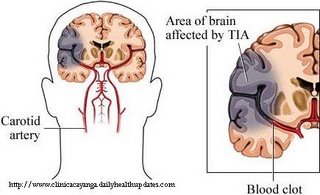| As the name implies, this condition occurs rapidly, lasts only for a few minutes or less than one hour after which the signs and symptoms completely disappear and the body returns to normal state. This occurs when the supply of blood to a part of the brain becomes temporarily blocked because of the presence of blood clot or plaques (cholesterol-containing fatty deposits) in an artery supplying the brain. This happens when while on your daily routine suddenly you feel weak or numb on one side of your body either on the face, arms, or legs. You want to ask the help of your companions but they have difficulty understanding you because your speech is slurred. You try to help yourself but you feel dizzy and there is loss of coordination in your movement. You also have difficulty looking around because of sudden blindness in one or both of your eyes. After several minutes suddenly you’re back to normal as if nothing happens. If these symptoms last for more than 24 hours then you are diagnosed to have a stroke. 
This condition occurs to people who have positive family history of TIA or stroke. The risk increases for those with hypertension, diabetes, cardiovascular diseases, hypercholesterolemia, obesity, sedentary lifestyle, and cigarette smokers. TIA is a warning for a more debilitating condition that is to come. It is therefore important to treat the risk factors and avoid or limit alcohol intake, cigarrette smoking, and fatty foods. Since a person is back to normal after an attack, oftentimes nothing is done to determine the cause. It is important for you to visit your physician in order that the abnormality which have caused the attack will be corrected so that occurrence of a stroke in the future could be prevented. |